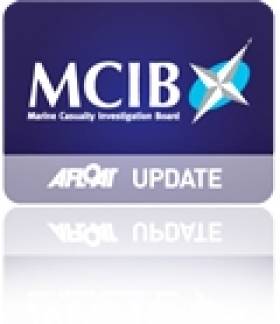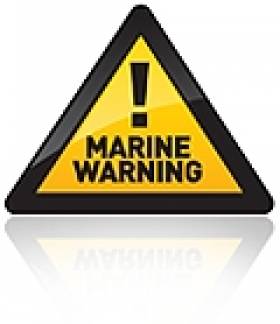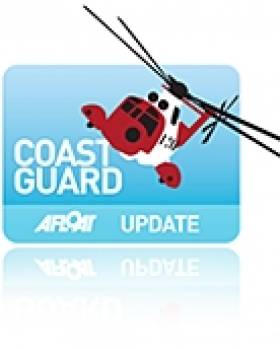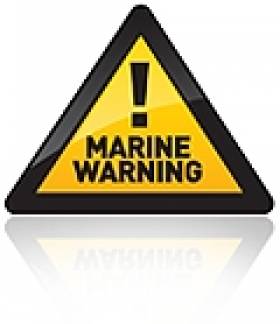Displaying items by tag: Lifejacket
Safety Advice for Leisure Boaters in MCIB's Helvick Head Report
#MCIB - The Marine Casualty Investigation Board (MCIB) has called for better safety awareness among leisure boat users in its report into the deaths of two men off Helvick Head in Co Waterford in May 2010.
John O'Brien and Pat Esmonde were lost overboard from their small RIB on 23 May 2010, and their remains were recovered two days later. Post-mortems confirmed that both died by drowning.
The report does not conclude exactly how the incident occurred. But accounts from eyewitnesses who sighted the men in the minutes before state that neither was wearing a lifejacket, despite the legal requirement to do so - and despite O'Brien having no seafaring experience and Esmonde being unable to swim, as confirmed by their families.
The MCIB also noted that while there were two lifejackets aboard the vessel, they were for emergencies and not suitable for constant wear as per the requirements for the vessel class.
Other safety issues highlighted include the kill-cord on the engine, which was not being used, and the fact that the initial distress call was made by mobile phone and not VHF radio.
Though neither had any bearing on this specific incident, the MCIB warned in particular that mobile phone calls are closed in nature, whereas VHF distress calls can be heard and answered by any vessel in the vicinity.
The board recommends that the Minister for Transport "undertakes a highly visible information poster campaign on piers and launching areas relating to lifejackets, VHF radio and emergency contact details" and also reminds boaters of their legal obligations.
The full report is available to download as a PDF from the MCIB website HERE.
Lifeboats Receive 1,000 Calls for Help in 2011
#LIFEBOATS – RNLI Lifeboats in Ireland launched 980 times to a variety of call outs in 2011. 905 people were rescued over the course of the year by volunteer lifeboat crews who spent over 9,826 hours on service at sea.
Howth RNLI lifeboat station in Dublin was the busiest coastal Irish station, launching to 48 requests for help and, bringing 60 people to safety. They were followed by Crosshaven RNLI in Cork who launched 46 times and assisted 43 people. Enniskillen, one of Ireland’s two inland RNLI lifeboat stations which operates bases on both Upper and Lower Lough Erne, launched 52 times and brought 46 people to safety.
The busiest month for rescues was July with 155 launches followed by August with 124 calls for assistance. February 2011 was the busiest February for Irish launches in the RNLI’s history, as were May and October 2011.
Over a third of the RNLI’s call outs for last year were also carried out in darkness. The statistics show that launches to vessels suffering machinery failure still account for the largest number of call outs (187) followed by vessels reported to be in trouble (78), grounded (74) and capsizing (73).
Commenting on the 2011 statistics RNLI Deputy Divisional Inspector Gareth Morrison said: ‘Our lifeboat volunteers continue to show selfless dedication and commitment to saving lives. Some stations are extremely busy while others have less call outs but spend long hours at sea in awful conditions. There were some outstanding rescues last year including that to Rambler 100, in which Baltimore RNLI recovered 16 crew members off the upturned hull of the racing boat during the Fastnet race. Sadly there were also long searches for missing loved ones.
‘The work of the volunteer lifeboat crews could not be made possible without the generosity of the public who in difficult times continue to support Irish lifeboat crews. While these figures give an interesting insight into search and rescue by the RNLI on Irish waters they are by no means the full story. As well as working to save lives at sea the RNLI provides other programmes and services for the public including sea safety advice and clinics, education roadshows and visits to lifeboat stations.’
The 2011 figures are being released in the wake of the RNLI Lifejackets for Lifesavers campaign which will see every lifeboat station in Ireland take delivery of new specially designed lifejackets in September. The lifejackets have been commissioned by the RNLI for search and rescue work and have been given the seal of approval from lifeboat volunteers. The cost of providing the lifejackets for all 43 lifeboat stations in Ireland is estimated at €160,000.
Report into Death of Crab Fisherman Prompts Call for Review of Stability Standards
#MCIB - The Marine Casualty Investigation Board (MCIB) has recommended a ministerial review of stability standards for fishing vessels following its report into the death of a crab fisherman off Co Cork in January last year.
Gerry Hegarty drowned after a wave struck the crab boat Carraig An Iasc, which was fully loaded with crab pots at the time, causing it to capsize and sending its two-man crew into the water.
Hegarty, who was not wearing a personal flotation device (PFD) or other buoyancy aid, got into difficulty while attempting to swim ashore with his crewmate and skipper James Fitzgerald, who subsequently raised the alarm.
Lifeboats from Ballycotton and Crosshaven, as well as Irish Coast Guard helicopter Rescue 117, were tasked to the incident. Divers from Naval Service vessel LE Emer located the sunken crab boat but no body was found.
A coastguard search of the area continued over a number of days without success. Hegarty's body was eventually recovered on 17 February 2011 at Ringabella Strand in Co Cork.
The MCIB found it probable that the Carraig An Iasc encountered wind or wave action or a combination of both that caused the vessel to heel to an angle beyond which it was able to recover from its loaded condition. The vessel's Code of Practice Declaration of Compliance was valid until 15 July 2013.
The board noted that there have been "a number of incidents caused by overloading boats thus effecting stability", and recommended that the Minister for Transport reviews and revises the stability standards in the current Code of Practice to improve these standards.
It was also recommended that a safety notice be issued to all skippers and owners in the fishing fleet reminding them of their legal responsibility to ensure that all their crew wear PFDs or lifejackets while on deck.
The full report is available to download as a PDF from the MCIB website HERE.
- Crosshaven
- Cork
- Safety
- Fishing
- Ballycotton
- Lifejacket
- Lifeboat
- Marine Casualty Investigation Board
- Coastguard
- Irish Coast Guard
- Skipper
- naval service
- helicopter
- MCIB
- Rescue 117
- personal flotation device
- Minister for Transport
- LE Emer
- standards
- drowned
- crab fishing
- Carraig An Iasc
- Gerry Hegarty
- James Fitzgerald
- PFD
- Ringabella Strand
- Code of Practice
- stability
- overloading
Epilepsy, Lack of Lifejacket Big Factors in Death of Dublin Boatman - MCIB
#MCIB - The death by drowning of a South Dublin boatman may have been avoided had he been wearing a lifejacket or buoyancy aid, according to investigators.
The report by the Marine Casualty Investigation Board (MCIB) into the death of Aidan Fennell off Dalkey Island on 12 October 2010 found that an epileptic episode could have caused him to fall overboard from his rowboat and become disorientated once in the water.
Fennell, 43, was considered a competent boatman and a strong swimmer used to cold water, though was prone to seizures where he could not control his muscles and lost sense with reality, on occasion becoming unconscious.
On the afternoon of 12 October last year Fennell had launched his boat from Coliemore Harbour in fair conditions, intending to ferry a German family to Dalkey Island. When they pulled out of the trip, Fennell decided to row to the island on his own, with no flotation devices on board.
He was last seen by friend Kevin O'Farrell at 2.50pm. Around half an hour later, O'Farrell became concerned as to Fennell's whereabouts when he had been out of sight for some time.
After notifying the Irish Coast Guard, the Dun Laoghaire lifeboat and coastguard helicopter Rescue 116 were dispatched to search the area. Fennell's boat was located before 4pm washed on the rocks at the southeast end of Dalkey Island, and his body was found in the water close by some 10 minutes later.
No injuries were found on Fennell's body, suggesting that he went into the water before his boat washed up on the rocks.
The report concluded that if he had fallen overboard in normal conditions "it is considered likely that he could have swum to his boat, or clung on to the oars.
"However, if he had suffered an epileptic episode... he would have had great difficulty in staying afloat, in particular without having the buoyancy assistance of a life jacket."
The full report is available to download as a PDF from the MCIB website HERE.
Is Your Lifejacket Safe? Free Test at Dun Laoghaire Marina this Sunday
Is your lifejacket safe? That's the question the RNLI is asking sailors this Sunday at Dun Laoghaire marina. And If last year's clinic's statistics is anything to go by then the answer is most likely no.
Over 90% of lifejackets tested at Ireland's two biggest sailing centres failed simple checks carried out by the Royal National Lifeboat Institute in 2010. From 91 jackets tested in Cork and Dublin, 83 failed a free inspection. More here.
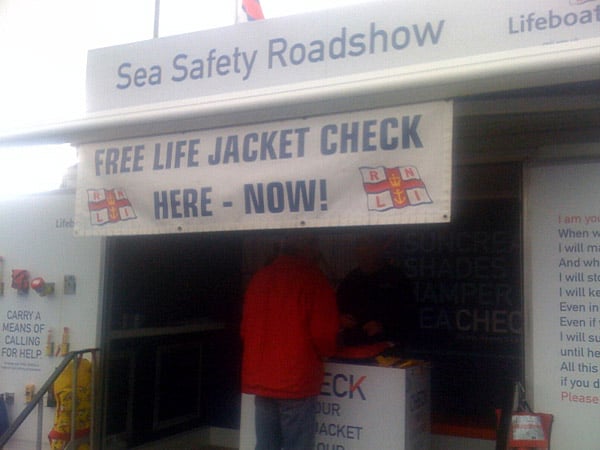
This year the Dun Laoghaire marina initiative with the RNLI aims to get more boat owners, sailors and crews to avail of the free test carried out at the clinic.
The Dun Laoghaire offshore lifeboat will be in the marina's Emergency Berth to allow you to get an close up inspectionand there will be RNLI personnel available to discuss any safety advice or search and rescue questions you may have.
The RNLI will also be taking bookings for a free onboard visit to your boat by the local Sea Safety Officer.
Will your lifejacket work when you need it? Do you know how to make sure it's a correct fit? Do you know how to look after it? All these questions and more will be answered by trained RNLI Sea Safety advisors.
You can learn the importance of choosing, fitting and the maintenance of a lifejacket from 11am to 4pm in Dun Laoghaire at the Lifejacket Clinic with RNLI Sea Safety Team. Likely topics as follows:
Which one?
There are many different types of lifejackets and buoyancy aids on the market. We can help you decide which one is best suited to your needs.
What size?
Size matters! A lifejacket or buoyancy aid will only work properly if it is properly fitted. We can show you how to adjust the lifejacket to a proper fit and why crotch straps are an essential part of the kit.
Looking after it.
It is essential to look after the buoyancy aid or lifejacket properly. With proper maintenance and regular servicing, your lifejacket will last longer and you can ensure it remains reliable. At our lifejacket clinic you can find out what checks to carry out on your lifejacket and how to care for it.
When to wear it?
RNLI volunteer crew wear a properly fitting lifejacket with crotch straps whenever the go afloat on the lifeboat, no matter what the weather. The RNLI believes that lifejackets are useless unless worn. All too often, RNLI crews recover people from the water who were not wearing lifejackets, and have not survived. A lifejacket can buy you time for the rescue services to get to you.
Free RNLI Lifejacket Clinic in Bangor
Anyone owning a lifejacket is invited to bring it along to the clinic and have it checked free of charge for safety.
During past lifejacket clinics, safety checks have revealed some astonishing potential life threatening maintenance issues.
This year Peter Bullick, a volunteer RNLI Sea Safety Officer and his dedicated team will be on hand to offer free lifejacket safety checks. They will also offer impartial advice on what maintenance action to take.
Quo Vadis Deaths Result of Misadventure, Says MCIB Report
Investigators have published their investigation report into the death of two yachtsmen off Inishboffin in October last year.
Donal McEllin, 63, and Ger Feeney, 56, died while attempting to return to their motor yacht Quo Vadis in the early hours of 10 October.
The inquiry by the Marine Casualty Investigation Board (MCIB) found that the pair had set off for the yacht - which was moored in Inisboffin Harbour - on a motor-driven inflatable tender after several hours socialising in Day's Pub on the island.
The report also found that they had declined an offer to be ferried back to the yacht.
A witness, Ian Day, recounted that he drove his jeep to the end of the pier and used his headlights to assure himself that the tender had reached the vessel. Though it had been agreed with both men that they would turn off the external lights on the vessel when they safely boarded, it was assumed that they had forgotten.
The bodies of both men were discovered the following morning. Mr. McEllin’s body was found lying on West Quarter Beach adjacent to where the vessel was moored, while Mr. Feeney’s body was found afloat, lying under the upturned tender. Mr. McEllin’s lifejacket had inflated but was entangled around his neck, indicating that the groin strap was not properly tied.
Based on the available evidence, the MCIB concluded that the deaths were the result of attemping a night-time transfer from a small inflatable boat to a larger vessel swinging on its mooring, combined with "possible tiredness and diminished human performance resulting from the effects of alcohol".
The full MCIB report is available for download below.
Lifejacket Saves a Life
Milford Haven coastguard was called at just after 4pm by the father of a 10 year old boy who had heard the elderly man calling for help. Milford Haven coastguard sent St. Govans Coastguard Rescue Team and an ambulance to the scene.
When help reached him it transpired that the elderly man was trying to repair his pennant mooring when he fell backwards in to the water. His lifejacket inflated but although he was 100 metres from the shore he wasn't a strong enough swimmer to swim against the tide back to the boat. He was in the water for around 30 minutes before the tide carried him in and he managed to scramble ashore.
Nigel Yelland, Watch Manager at Milford Haven Maritime Rescue Coordination Centre said:
"The MCA recommends that recreational sailors should wear lifejackets at all times while on deck and this afternoon's accident is a perfect example of why. Without a lifejacket this elderly gentleman is unlikely to have managed to keep his head above water for half an hour.
"I'd like to thank the caller and his son for both alerting us and racing to the rescue."
Launching? Check Your Boat Maintenance
"Many of the water-based incidents that we deal with at this time of year involve engine breakdown as a result of lack of maintenance," says Garry Hall of the UK's Solent Coastguard. "People report running out of fuel, sometimes because fuel indicators are broken or because fuel can't get through pipes and the engine is starved. Electrical issues are also a frequent problem. Often oxidation happens if engines are laid open to the elements and it affects the wiring. Engines are susceptible to frost so following our cold winter they will certainly need a good service."
Ideally attend a Diesel engine maintenance course, see:
www.rya.org.uk/coursestraining/courses/specialist/Pages/Diesel.aspx
Whilst you're considering maintenance, don't forget to look at your lifejackets and make sure that they are functioning fully. Remove the cylinders and auto-mechanisms, washing them in fresh water. Now inflate the lifejackets using a hand pump, leaving them for 24 hours to make sure that they don't deflate. Then reassemble the lifejacket, ensuring that the cylinder is screwed back in securely. The RNLI have some good advice about how to maintain your lifejacket on their website. Go to www.rnli.org.uk/seasafety
Appropriate and fully functioning communications equipment will be vital should you find yourself in an emergency situation. Have you got all the right equipment?
Check all your existing communication equipment. Ensure your VHF DSC radio unit's MMSI registration is up to date with Ofcom so that the Coastguard has the right emergency contact details. If you have an emergency position-indicating radio beacon (EPIRB) or a personal locator beacon (PLB), replace batteries before they expire and don't just rely on the "test" button. Also ensure the beacon's registration details are up to date so that the Coastguard has the right emergency contact details and correct information for both yourself and your vessel.
Lost Larne Lough Fisherman 'Not Wearing Lifejacket'
An inquest into the death of a Larne man who drowned after his boat capsized in Larne Lough has heard that he and his fishing partner 'could not afford lifejackets'.
The News Letter reports that 29-year-old Graeme Nixon disappeared in the water when his small vessel seized and nosedived in Larne Lough. In land waterways.
His friend on board was able to swim to shore and raise the alarm, but Nixon's body was not recovered until two weeks later.
The court heard that a problem with an engine seal was the cause of the seizure, which would have been prevented by servicing.
Nixon was returning from fishing for whelks with John Kyle in a heavily laden boat when the accident occurred, just 200 metres from the shore.
The deceased father-of-two had been eager to pay for his upcoming stag night and a planned Christmas trip to New York for his fiancée.





























